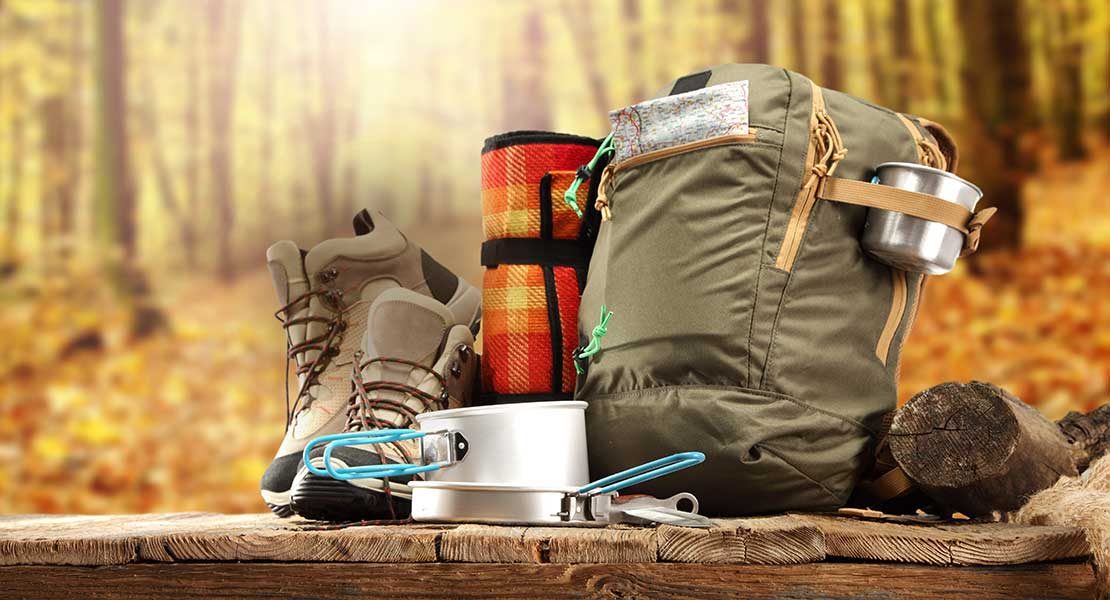A Beginner’s Guide to Backpacking Trips

Pretty soon, the colors of the Lehigh Valley will assume their brilliant autumnal mélange of orange, yellow, and red. It’s the most beautiful time of the year to get outside. As luck would have it, there are trails right in our backyard just waiting to be used. While you could just clear your schedule next Saturday afternoon for a two-mile trek, there are countless reasons why you should clear next weekend’s plans and go hiking—or, better yet, backpacking.
Never done it before or don’t have the equipment? The thought can be intimidating, but don’t worry—we’ve got you covered. Whether you’re an experienced hiker or just starting out, backpacking trips are a rewarding way to spend time in nature, and it’s easy if you have the right gear.
Check out our trail guide for where to go if you want an easy stroll, a challenging hike, a walk with your dog, or—if you’re ready—to spend the night in nature.
Clothing and Shoes
It’s arguable that footwear is the most important piece of gear to have. You’ll be walking on a variation of dirt, rocks, roots, and puddles, so it’s crucial that you have supportive footwear with good, grippy outsoles to keep you feeling confident on the trails. Fit is of utmost importance, and the best way to purchase hiking boots is to stop at a local outfitter and try them on yourself. Remember that there isn’t one perfect shoe or brand for every person. The right one for you is the one that fits. (Don’t forget to wear them around the house for a few days to break them in!)
As for clothing, forget about cotton. Cotton retains moisture, therefore making things generally uncomfortable. This means that all of your clothing—socks, underwear, pants and bottoms—should be made of a synthetic material (like polyester and nylon) or merino wool. All have generally the same purpose: to wick moisture from your body to keep you dry and cool, while at the same time providing you warmth when you’re cold.
This doesn’t mean you have to go and drop a stack of cash on a brand new wardrobe. If you’re a runner, yogi, or gym rat, you’re probably halfway there. Just check the fabric content—if the material has little to no cotton in it, you’re good. For a two-day trip, all you need is a pair of pants or shorts, two shirts, two pairs of underwear and socks, plus something to sleep in. If the forecast is looking sketchy, bring a rain jacket, and the temperature will determine if you need an insulating layer as well.
The Backpack, Tent, and Sleeping Gear
The most essential gear you need for backpacking is—you guessed it—a backpack. (And we aren’t talking about that Jansport bag from college.)
Check out our trail guide for where to go if you want an easy stroll, a challenging hike, a walk with your dog, or if you’re ready to spend the night in nature.
A 30-50 liter pack is just about the size you need to hold your food, water, and other gear for the weekend. Make sure that the pack fits your body correctly, especially with your torso length and waist size in mind. While you can do these measurements yourself at home, this is piece of gear that’s best purchased at an outfitter where you can get fitted by a professional. Easton Outdoor Company in Easton is one such locale.
Sleeping bags are simple. Be sure to get one that’s the right length and the right warmth for the season. Typically, a sleeping bag will be filled with down or a synthetic material—down is the usually the warmest option and tends to be more lightweight. The lighter weight, the better (you’re carrying it, after all!). Because no one wants to sleep with rocks and sticks poking their backs, grab yourself a sleeping pad, too.
Speaking of sleeping, a one-person tent is good for yourself, but if you’re sharing a tent, get a two-person (just prepare yourself for some close quarters). A three-person is roomier for two people, but remember that the bigger the tent, the more weight you’re carrying.
Food and Water
All of this trekking calls for lots of hydration, and the most convenient option is to get a “water bladder” that you can fill up and slide right in your pack. You also shouldn’t just take any water from the ground and drink it, so you’re going to to need a method for purification. The least expensive and easiest are iodine tablets, which kill bacteria, viruses, and giardia.
For food, stock up on dehydrated meals that just require boiling water to prepare. All you’ll need is a compact stove, matches, plus a bowl and utensils to eat with. Be sure to pack plenty of snacks like trail mix, jerky, energy bars, and any other high-calorie and high-protein foods you like, because you’re
working hard!
Everything Else
A first aid kit should always be on hand, even for a day trip. Most major retailers sell pre-packed kits so you don’t need to worry about what to fill it with. Of course, bring any medications you need, plus a few extra just in case.
Toilet paper is nice to have on hand for when you have to “go” (look up the right way to do it while on the trail, because there is one), plus hand sanitizer and any other small toiletries you may need and can fit in your pack. Keep these things in more accessible pockets. Don’t forget a small lantern or headlamp so you can see at night.
Those are the basics. You might be thinking this is too much work or too expensive, and sure, it can be. But don’t be discouraged. If all of this gear is out of your budget, start out small with a pair of good hiking shoes or boots, go for longer day hikes, and then slowly start building up your stamina and collection of gear.
Try joining a local hiking club, look into beginner backpacking classes, or find an experienced friend to join you or help to get you started. Once you have everything you need, hit the trails! We bet you’ll love it.
TRAIL GUIDE
Bake Oven Knob to Lehigh Gap
This section-hike of the Appalachian Trail is perfect for a first backpacking trip. Start at Bake Oven Knob early in the morning to log in just over eight miles of mostly rugged trail. The end result is a beautiful view of the Lehigh River, and after taking that all in, you can turn around and find a spot off the trail to stay for the night before heading back in the morning.
Miles: 16.4 out and back
Difficulty: Hard
Camping Permitted: Yes
Dog-friendly: Yes
Glen Onoko Falls
While this loop in Lehigh Gorge State Park has quite some elevation to climb, the three waterfalls are well worth the trek. Hiking shoes or boots are highly recommended—the trails are rocky and slippery in spots.
Miles: 7.4
Difficulty: Hard
Camping Permitted: No
Dog-friendly: Yes
The Pinnacle Trail Loop
Not far from Hawk Mountain is The Pinnacle, which boasts one of the greatest views in the Lehigh Valley. Like most Pennsylvania trails, this is a rocky one, with some parts demanding more climbing than just walking. While this is easily day-hiking material, you could bring your backpacking gear to make this an overnight excursion if you’re just starting out.
Miles: 8.9
Difficulty: Moderate
Camping Permitted: Yes
Dog-friendly: Yes
Hawk Mountain Lookout Trail
This popular, family-friendly trail is ideal for those looking to catch a glimpse of local raptors like hawks and eagles. The 4.5-mile Lookout Trail Loop starts at the Hawk Mountain Sanctuary visitor center and features a number of vistas throughout. Additionally, there’s easier, ADA-certified walkway leading up to the first lookout that’s about 900 feet long.
Miles: 4.5
Difficulty: Moderate
Camping Permitted: No
Dog-friendly: No
Trexler Border Trail
Part of the Trexler Nature Preserve and circling outside of the Lehigh Valley Zoo, the Trexler Border Trail offers more approachable terrain with short climbs and great views of the meadows and foothills of the Lehigh Valley.
Miles: 8.5
Difficulty: Moderate
Camping Permitted: No
Dog-friendly: Yes
Jordan Creek Trail
Built alongside Jordan Creek, this is a peaceful, family-friendly spot that’s great to visit if you don’t have the whole day for a hike, but want to get a quick nature fix.
Miles: 2.4
Difficulty: Easy
Camping Permitted: No
Dog-friendly: Yes














